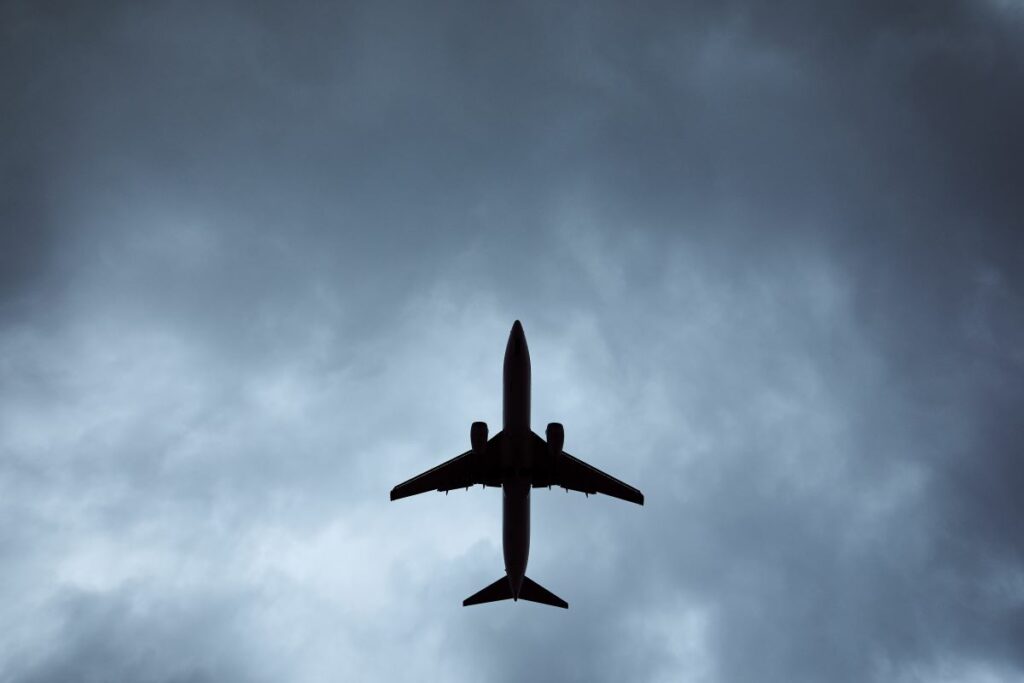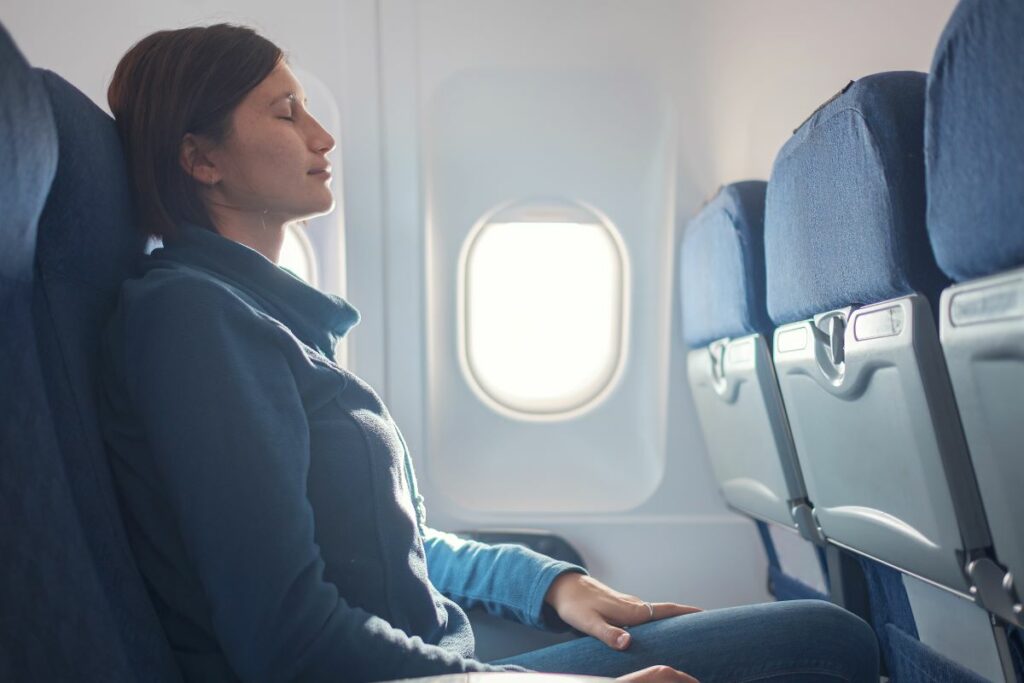Dealing with turbulence anxiety is a common challenge for many air travelers. Turbulence, the often unexpected bumps and jolts experienced during flight, can trigger anxiety even in seasoned passengers.
The fear stems from a lack of control and the unpredictability of these aerial conditions. While turbulence is a normal and typically harmless part of flying, the associated anxiety can significantly impact a passenger’s comfort and overall travel experience.
Experts suggest several strategies to cope with this anxiety. One key approach is understanding that turbulence is a regular occurrence and that aircraft are designed to withstand it.
In addition, passengers are encouraged to become familiar with the safety features of the aircraft and listen carefully to the pre-flight safety demonstration. Deep breathing exercises, staying hydrated, and avoiding caffeine and alcohol can also help manage physiological responses to anxiety.
For those whose anxiety persists despite these measures, it may be beneficial to consult with a mental health professional who specializes in the fear of flying.
They can provide personalized techniques and potentially recommend therapeutic interventions that can reduce the intensity of turbulence anxiety over time.
Engaging with support groups or educational resources on air travel can further demystify the experience and help passengers gain confidence in their ability to manage their apprehension.
Explore emotional well-being with BetterHelp – your partner in affordable online therapy. With 30,000+ licensed therapists and plans starting from only $65 per week, BetterHelp makes self-care accessible to all. Complete the questionnaire to match with the right therapist.
Understanding Turbulence

To effectively manage turbulence anxiety, one must first comprehend the mechanics of air turbulence and distinguish between reality and common misconceptions.
Causes of Turbulence
Turbulence is primarily caused by the natural phenomenon of air movement within the Earth’s atmosphere. It can occur when wind sweeps across irregular ground surfaces or obstacles, creating swirling eddies.
Variations in air temperature, which affect air density, can also lead to turbulence. This is particularly prevalent near the equator where the sun heats the Earth’s surface intensely.
At high altitudes, the jet stream, a fast-flowing river of air, can result in choppy conditions for aircraft due to its significant wind speeds and the shifting zones of different temperatures and pressures it creates.
Myths Versus Facts
| Myth | Fact |
|---|---|
| Turbulence can cause an aircraft to crash. | Modern aircraft are designed to withstand even severe turbulence, and pilots are trained to navigate through it safely. |
| Turbulence is completely unpredictable. | While turbulence can be unexpected, meteorologists and pilots use technology to forecast areas of potential turbulence, including monitoring the jet stream and storm patterns. |
Severity Levels
Turbulence intensity can range from mild to severe and is classified as follows:
| Level | Description |
|---|---|
| Light Turbulence | Causes slight, rapid, and somewhat rhythmic bumpiness without significant changes in altitude or attitude. |
| Moderate Turbulence | Results in rapid bumps or jolts, with some difficulty in walking or holding onto objects. Unsecured objects may be displaced. |
| Severe Turbulence | Causes large, abrupt changes in altitude or attitude, with considerable strain against seat belts and difficulty in controlling the aircraft. |
While turbulence is influenced by a myriad of factors, including the Earth’s rotation which affects linear speed and centrifugal force, and mixing of air currents of varying temperatures and speeds, it remains a normal and navigable part of flying.
Physiological Response to Turbulence

When experiencing turbulence, the body may exhibit signs of stress as part of the physiological response to what it perceives as a threat.
This section will delve into the biological mechanisms underpinning such reactions and ways to manage these involuntary responses.
Understanding Fear and Anxiety
Fear and anxiety are natural responses to perceived threats.
During turbulence, an individual’s sympathetic nervous system activates, releasing stress hormones, such as adrenaline, that prepare the body to either fight or flee where alertness increases, heart rate accelerates, and muscles tense.
This “alarm” response heightens one’s senses and readies the body for action.
Therapists Specializing in Anxiety
Managing Panic and Stress Reactions
To manage panic and stress reactions, it’s essential to engage the parasympathetic nervous system, the body’s natural counterbalance to stress.
This can be achieved through deep, rhythmic breathing which helps to reduce the stress response and elicit a state of calm.
Evidence of individuals managing stress by controlling their response to challenging situations hints at the applicability of such techniques in managing distress during turbulence.
Additionally, focused distraction such as listening to music or practicing mindfulness can divert attention away from anxiety.
By recognizing and understanding these physiological signs of anxiety and nervousness, individuals can employ techniques to manage their response, ensuring that the distress experienced is addressed in a confident and proactive manner.
Practical Tips to Handle Turbulence

Dealing with turbulence anxiety effectively involves a combination of controlled breathing, mental distraction strategies, and cognitive behavioral techniques.
These methods can significantly help fearful fliers manage their stress responses during turbulent flights.
Breathing Techniques
One of the first steps in controlling turbulence anxiety is to practice deep breathing. Inhale slowly through the nose, allowing the stomach to expand, and then exhale slowly through the mouth.
This can decrease the physiological symptoms of anxiety.
- Inhale: Slowly count to five while breathing in.
- Hold: Hold the breath for a count of three.
- Exhale: Breathe out slowly to the count of five.
Distraction and Focus Strategies
Redirect attention by solving a puzzle, reading, or engaging in a conversation. These activities require focus and can provide a helpful distraction from the anxiety caused by turbulence.
| Puzzles | Reading | Conversation |
|---|---|---|
| Crosswords, Sudoku, or a game on a device. | A book or magazine that requires concentration. | Discuss an interesting topic with a seatmate or flight attendant. |
Cognitive Behavioral Approaches
For frequent fliers or those with severe turbulence anxiety, working with a therapist using exposure therapy can be useful.
It involves gradual exposure to the sensation of turbulence in a controlled environment, reducing fear over time.
| Guided Imagery | Virtual Reality Simulations |
|---|---|
| Therapist helps visualize a flight with turbulence while practicing relaxation techniques. | Some therapists offer virtual reality sessions to mimic the experience of turbulence. |
Common Concerns Addressed

When discussing turbulence anxiety, it’s crucial for passengers to understand the realities of flight turbulence.
The subsequent subsections provide clear facts on potential injuries, reporting practices, and strategies to manage fear.
Risks of Injuries
Severe turbulence can lead to injuries if passengers are not securely fastened in their seats with their seatbelts. However, incidents where a plane falls drastically are extremely rare.
The Federal Aviation Administration (FAA) mandates that all passengers comply with the seatbelt sign to mitigate this danger.
Despite sensationalized media narratives the likelihood of needing medical attention due to in-flight injuries is comparatively low.
Incidence and Reporting
Instances of severe turbulence are meticulously reported by airlines and monitored by aviation authorities.
Contrary to some exaggerated media reports that may create a distorted image of the dangers of flying, airlines have strict protocols for reporting any turbulence incidents.
This helps ensure transparency and collects data to continually improve passenger safety.
Mitigating Fear During Flight
Passengers can take steps to mitigate fear during flights experiencing turbulence. One method is to understand that pilots are trained to handle various turbulence levels and prioritize safety over speed or convenience.
While stories of a plane needing to make an emergency landing due to turbulence might be alarming, these are precautionary measures rather than indicators of impending danger.
Passengers can also distract themselves with in-flight entertainment or relaxation techniques to reduce anxiety.
Preparing for Your Flight

To ensure a comfortable journey and manage anxiety, key aspects such as seat selection, gathering pre-flight information, and creating a personal coping strategy are essential.
Choosing the Right Seat
Selecting the right seat on an aircraft can significantly affect one’s experience, especially when concerned about turbulence.
Seats over the wings generally experience less motion during turbulence, potentially offering a smoother flight.
Flight experts often recommend aisle seats for easy access, which can help reduce feelings of confinement that may exacerbate anxiety.
Pre-Flight Research
Staying informed about the flight and potential weather conditions can help prepare for the possibility of turbulence.
One might check aviation news for updates on the route or consult the International Air Transport Association (IATA) to understand airline safety measures.
Creating a Personal Coping Plan
Developing a personal plan to cope with turbulence can provide a sense of control and alleviate anxiety.
Such a plan may involve activities to divert attention, like reading or listening to music, and using deep-breathing techniques when the seat belt sign illuminates.
Understanding that modern aircraft are designed to withstand storm instability also helps passengers maintain their composure during flights.
Frequently Asked Questions

What are the best strategies for managing anxiety during flight turbulence?
One of the best strategies is to familiarize oneself with the normalcy of turbulence; understanding that it is a common part of flying can alleviate fear.
Breathing exercises and listening to calming music can also help maintain a sense of control during bumpy conditions.
During what times of the year is flight turbulence most common?
Flight turbulence is most likely to occur during the late spring and summer months due to the occurrence of thunderstorms and convective currents. However, jet streams can cause turbulence during the winter months as well.
How can passengers transform their experience of turbulence into a more enjoyable one?
Passengers can reframe their experience by viewing turbulence as a normal occurrence akin to potholes on the road.
Using the time to immerse in an engaging activity like reading or watching a movie can also distract from the turbulence.
What methods are effective in reducing nausea and sickness due to turbulence?
To reduce nausea, passengers can focus on steady, deep breaths and avoid reading or looking down. Ginger, whether in the form of candies, tea, or supplements, is known to be an effective natural remedy for motion sickness.
What safety measures do airplanes have in place to handle severe turbulence?
Airplanes are equipped with advanced technology to detect and avoid severe weather and turbulence, and pilots are trained extensively to navigate turbulent conditions.
Aircraft design also ensures planes can withstand with much greater stresses than those encountered during routine turbulence.
What techniques can help overcome a general fear of flying?
Techniques like Cognitive Behavioral Therapy (CBT) are often recommended to address the underlying thoughts contributing to a fear of flying.
Classes offered by airlines and sessions with professional therapists specializing in phobias can empower passengers to confront and overcome their fears.









